Are you looking to add some annual flowers to your Michigan garden that thrive in Michigan climates? Look no further! We compiled a convenient list of the nine best annual flowers for Michigan gardens at all experience levels. Enjoy our recommendations for easy-to-grow annual flowers, perfect for gardeners in the Wolverine State.

1. Coleus
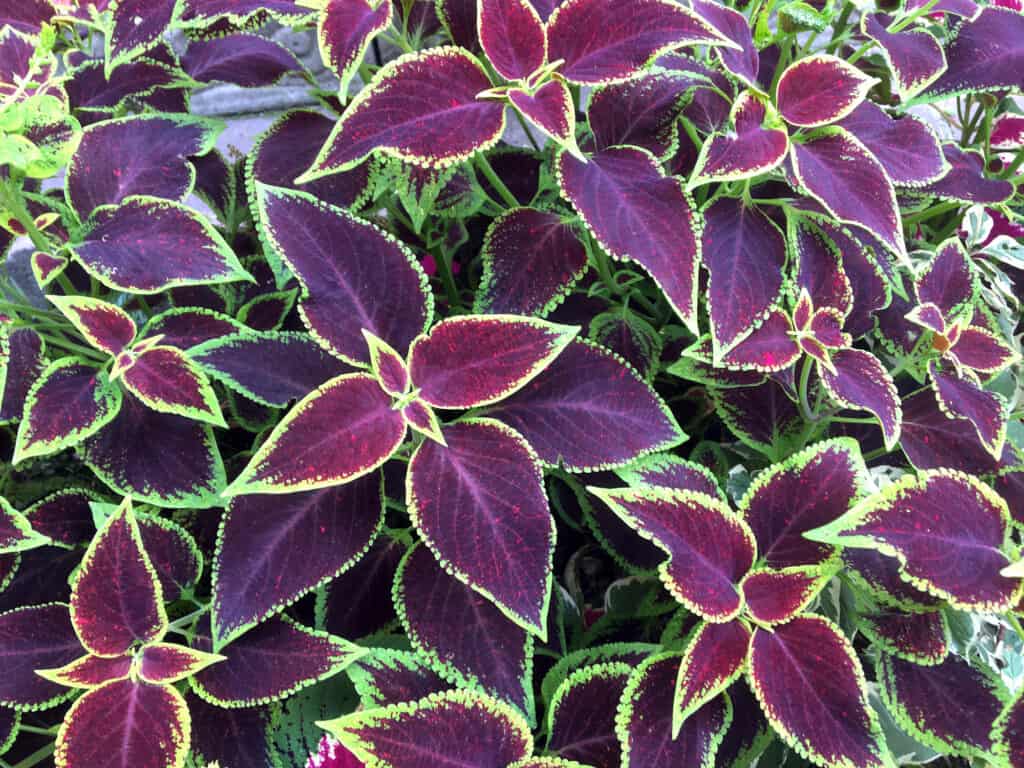
Coleus plants are grown for their foliage.
©iStock.com/robybret
The coleus plant has brilliantly showy foliage that stands up to any bloom! Plus, coleus cultivars show up on best-of lists in Michigan plant trials. So we’re adding coleus among the best annual flowers for Michigan gardens because this gorgeous plant deserves a place of honor in any flower bed.
Perhaps the most iconic coleus leaves come with dark pink centers and bright lime green borders. Other coleus cultivar hues include orange, red, purple, copper, and white. In addition, coleus leaf shapes are varied and interesting, from deeply lobed leaves to oval shapes with serrated edges.
Coleus plants are sun-loving annuals that reach 12 to 24 inches tall at maturity. They’re perfect for adding colorful foliage to the landscape and filling in gaps in shady areas of the garden.
Coleus (also called painted nettle) is part of the mint family but doesn’t have a minty smell. Some people think coleus smells like camphor trees. And some people believe coleus’s pungent aroma is just plain unpleasant. However, coleus leaves only release a strong fragrance when brushed or crushed. Plus, their scent tends to keep deer out of your garden.
Quick tips for planting coleus in Michigan:
- Coleus plants perform best with morning sun and afternoon shade, though some cultivars have different sunlight needs.
- Use rich, well-draining soil with plenty of organic matter.
- Keep coleus soil moist (not soggy), and don’t let it dry out.
- Fertilize coleus plants in the morning (after watering) about once a month.
2. Lantana
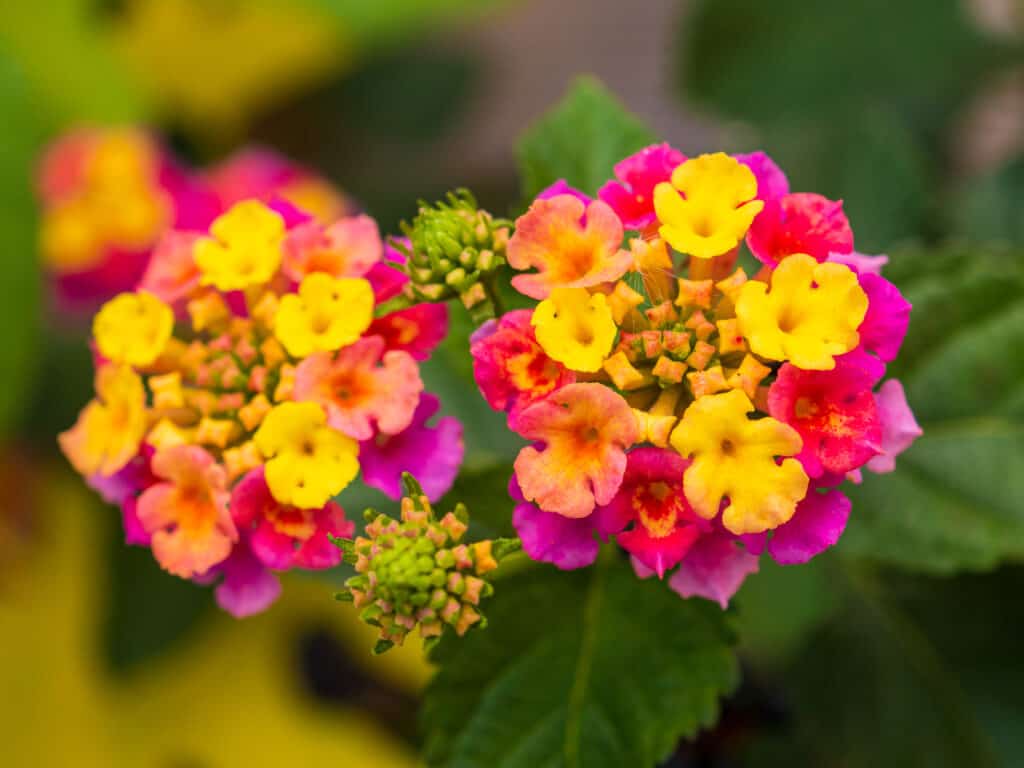
Lantana flowers are sun-loving plants ideal for Michigan gardens.
©galitsin/Shutterstock.com
Lantana plants are heat-tolerant and drought-resistant, making them ideal for Michigan gardens. In Michigan, lantana blooms from June through October. Lantana is an ideal annual flower for attracting pollinators like bees and butterflies.
This sun-loving plant produces multi-colored clusters of tiny bright flowers in yellow, orange, pink, or white. Lantana plants can reach 2 to 3 feet tall at maturity (depending on the cultivar) and have a mounded growth habit. They’re perfect for adding color to sunny borders, mass plantings, and containers.
Quick tips for planting lantana in Michigan:
- Lantana plants perform best in full sun but also enjoy partial shade.
- Well-drained soil is a must. Lantana doesn’t like wet feet.
- Lantanas are drought tolerant once established, but they’ll perform best if you keep the soil moist during their first growing season.
- Fertilize lantana plants monthly with a balanced fertilizer.
3. Marigold

In Michigan gardens, marigolds add a touch of brightness.
©FunFamilyRu/Shutterstock.com
Marigolds are excellent annual flowers for Michigan gardens, and it’s no wonder. These cheerful flowers are easy to grow and add a touch of brightness to any landscape.
There are two main types of marigold plants: African and French. French marigolds (Tagetes patula) are smaller than African marigolds (Tagetes erecta) and have a more delicate appearance. Both marigolds produce bright round pom-pom flowers in yellow, orange, or red.
Marigolds are sun-loving annuals that reach 12 to 36 inches tall at maturity. Like lantana plants, marigolds have a mounded growth habit and grow beautifully in containers.
Quick tips for planting marigolds in Michigan:
- Marigolds grow best in full sun to partial shade.
- Water marigolds once a week, but more often in containers.
- Go lightly with balanced fertilizers for marigolds or skip them altogether. Adding too much fertilizer might decrease blooms and increase foliage.
- Marigolds benefit from regular deadheading (removal of dead blooms) by promoting more flowering.
4. Million Bells
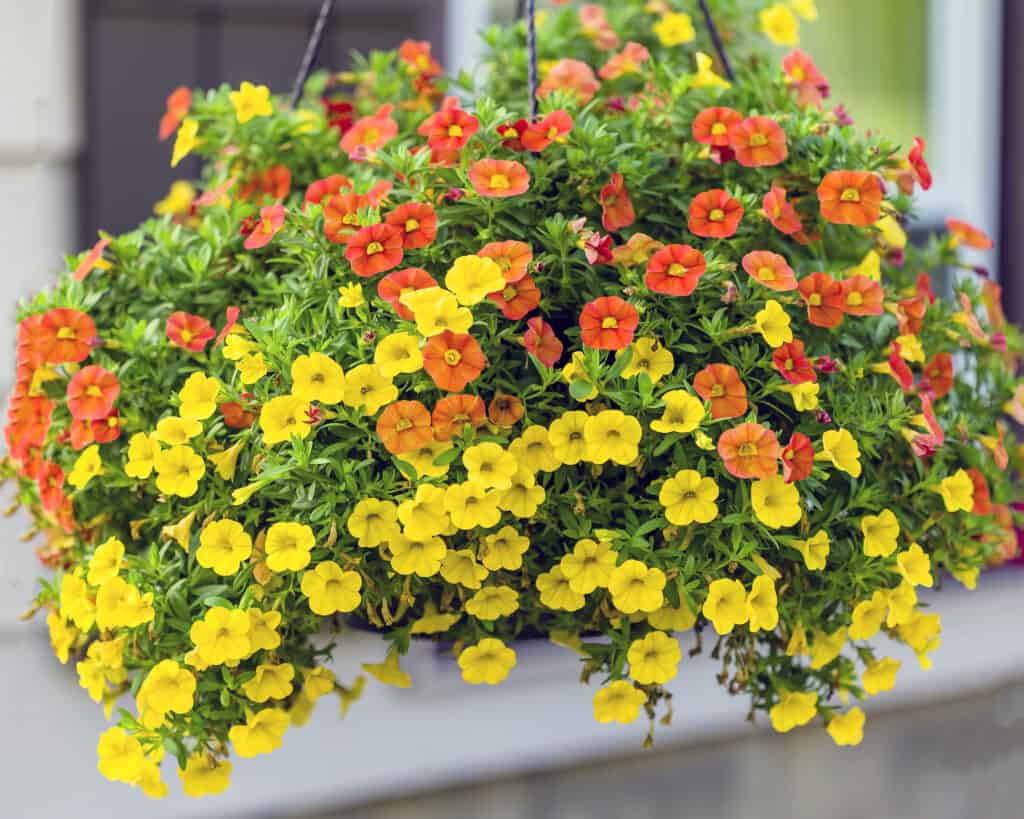
As the name implies, million bells flowers are bell-shaped.
©iStock.com/Mark R Coons
Million bells (Calibrachoa) is a petunia relative prized for its continuous bloom production. And a handful of million bells cultivars ranked high in Michigan State University’s 2021 trial gardens! That’s pretty powerful proof that million bells thrive in Michigan gardens.
These pretty annual plants produce an abundance of small, bell-shaped flowers in shades of pink, purple, red, orange, yellow, and white.
Million bells plants are sun-loving annuals that have a trailing growth habit. They’re perfect for filling in gaps in sunny borders and hanging over the edges of containers. Million bells plants typically reach 4 to 10 inches tall at maturity but can trail up to 3 feet or more.
Quick tips for planting million bells in Michigan:
- Million bells grow best in full sun and tend to grow better in containers due to their trailing habit.
- Use well-drained, fertile soil for best results.
- Water million bells plants when the top 1-2 inches of soil becomes dry. Water more frequently on hot days.
- Million bells are self-cleaning, so they don’t require deadheading often, if at all.
5. Petunia

Make sure petunias get at least five hours of sunlight each day.
©pakn/Shutterstock.com
Petunias are among the best annual flowers for Michigan gardens due to their hardiness in Zone 5 from spring to fall. Their trumpet-shaped blooms come in many vibrant colors, bloom all summer long, and add a bit of whimsy to any Michigan landscape.
Grandiflora petunias have large flowers and a mounded growth habit. Multiflora petunias have smaller flowers and a more trailing habit.
Petunias are sun-loving annuals that reach 6 to 16 inches tall at maturity. Grandiflora petunias grow tall, whereas trailing multiflora petunias have a wider spread and stay lower to the ground.
Quick tips for planting petunias in Michigan:
- Make sure petunias get at least 5-6 hours of sunlight each day.
- Water petunias once or twice per week, but more often in containers.
- For multiflora (spreading) petunias, fertilize the plants twice a month. Grandiflora petunias need fewer applications or a slow-release fertilizer.
- Remove dead petunia blooms often, so the plants bloom continuously throughout the growing season.
6. Salvia
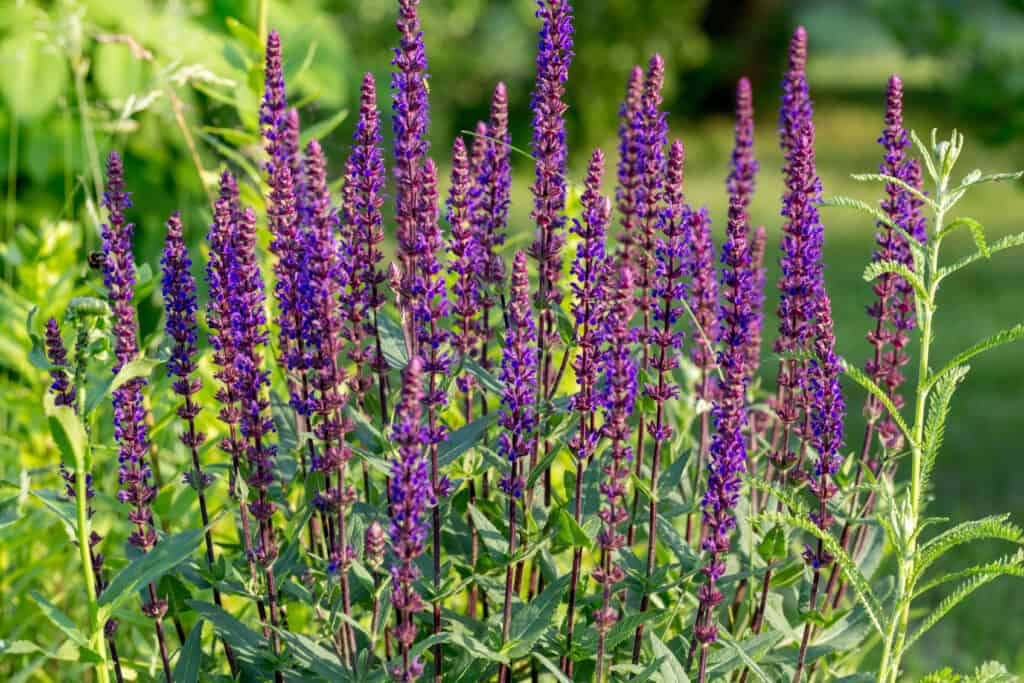
Salvia’s trumpet-shaped blooms look similar to lavender.
©Olga_Ionina/Shutterstock.com
Salvia is a flowering annual prized for its showy blooms and long flowering season. Michigan gardeners love growing salvia plants in their landscapes because they attract pollinators while adding color and texture.
The tiny trumpet-shaped blooms of salvia plants grow on tall spikes that look similar to lavender. Salvia has a mounded growth habit and ranges in height from 12 to 36 inches at maturity.
There are many types of salvias to choose from, but some of the most popular varieties for Michigan gardens include:
- Salvia farinacea (mealycup sage): This variety blooms in shades of blue, pink, or white and reaches 2 to 4 feet tall at maturity.
- Salvia nemorosa (woodland sage): This variety blooms in shades of blue, lavender, or white and reaches 12 to 36 inches tall at maturity.
- Salvia x sylvestris (meadow sage): This variety blooms in shades of blue, pink, purple, or white and reaches 15 to 20 inches tall at maturity.
Quick tips for planting salvia in Michigan:
- Most salvias prefer full sun.
- Salvia plants are drought-tolerant and don’t require a lot of water. Check their soil before watering to make sure the top inch is dry.
- Your Michigan-grown salvia flowers probably only need to be fertilized at the beginning of each growing season, in the spring.
- It’s important to deadhead the spent bloom spikes from your salvia plants. Cut plants back by a third after their first flowering of the season to allow them to bloom again.
7. Sunflower
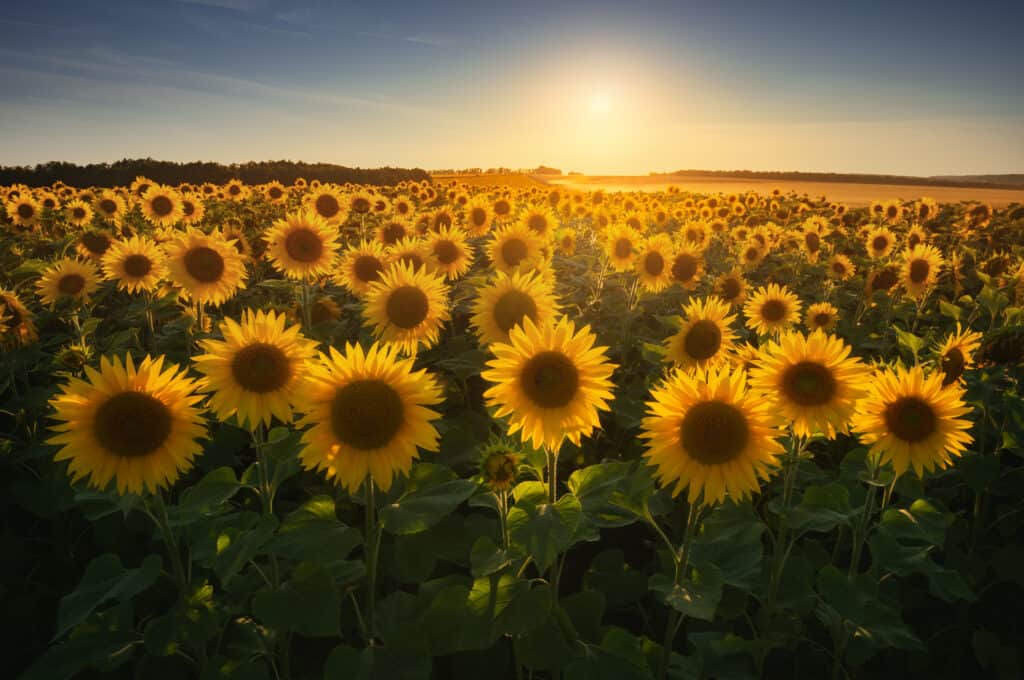
Sunflowers are annual flowers that thrive in Michigan.
©iStock.com/oleshkonti
Many sunflower varieties thrive as annual flowers in Michigan. These cheery flowers brighten any garden with their large, daisy-like blooms that come in shades of yellow, orange, red, and brown.
Most sunflowers have a single bloom on each stem, but some varieties produce multiple flowers per stem. Sunflower plants can range from 1 to 12 feet tall at maturity, depending on the variety.
Some popular sunflower varieties for Michigan gardens include:
- Helianthus annuus (common sunflower): This is the most popular type of sunflower with blooms up to 12 inches wide. Plants grow 6 to 12 feet tall.
- Helianthus multiflorus (many-flower sunflower): This variety has smaller blooms than the common sunflower but produces multiple blooms per stem. Plants grow 3 to 6 feet tall.
- Helianthus debelis (Italian white sunflower): This is a hybrid sunflower with white petals and a yellow center. Plants grow 3 to 4 feet tall.
Quick tips for planting sunflowers in Michigan:
- Sunflowers need full sun to thrive in a garden bed with at least 6 hours of sunlight each day.
- Water sunflower plants about once a week until the top 5 or so inches of soil is moistened.
- Sunflowers do well with yearly fertilization at the start of the growing season, with a slow-release fertilizer.
- To prevent common sunflowers from getting too tall and toppling over, you can stake them or plant them in an area where they’ll have some support, like next to a fence.
8. Verbena

Because it is low-growing, verbena can be used as a ground cover in a garden.
©Flower_Garden/Shutterstock.com
Verbena is a heat-loving annual flower often used as a border plant or ground cover in Michigan gardens. This low-growing flower comes in shades of pink, purple, blue, and white and has a long blooming season.
Most verbenas have cluster flowers with tiny star-shaped blooms. Depending on the variety, verbena plants reach about 6-18 inches tall at maturity. Some verbenas have a mounded growing habit, while others are upright or trailing plants.
Quick tips for planting verbena in Michigan:
- Most verbenas prefer full sun but can tolerate some light shade.
- Plant verbena in well-drained soil amended with compost.
- Water your verbena plants about once a week, letting the soil dry between waterings.
- Verbenas don’t need to be fertilized often. Still, they may benefit from a light feeding once or twice during the growing season.
- To keep your verbena plants looking their best, deadhead the spent blooms.
9. Zinnia
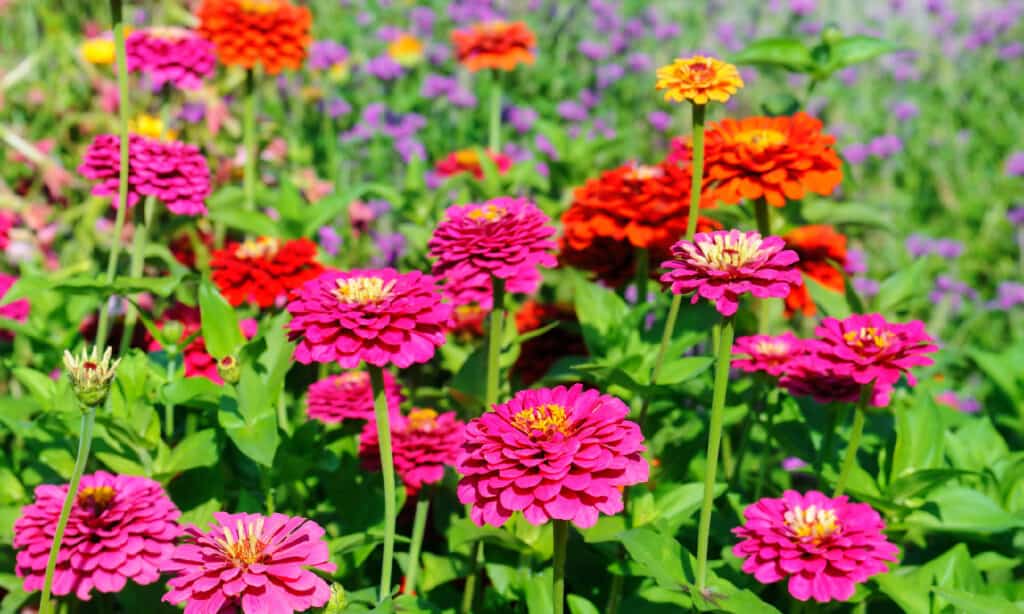
The zinnia flower attracts pollinators.
©iStock.com/AlinaMD
Zinnias are among the best annual flowers for Michigan because they’re so easy to grow and maintain. Plus, zinnias have long-lasting blooms in the ground and flower arrangements. These heat-loving plants also have a long blooming season and attract butterflies and other pollinators to the garden.
These colorful flowers come in many colors, including pink, purple, red, yellow, and white. Zinnia plants have daisy-like blooms with single or double petals. Depending on the variety, like giant or dwarf zinnias, these annual flowers reach anywhere from 6 inches to 4 feet tall.
Quick tips for planting zinnias in Michigan:
- Zinnias need full sun for best performance. Use non-clay soils to avoid root rot.
- Water your zinnias a couple of times a week or water them enough to keep their soil moist. However, don’t overwater zinnias, or they develop rot and fungal diseases.
- For growing in cutting gardens, practice succession planting to keep more flowers popping up all season long. A simple definition of succession planting is to plant a new crop immediately after (or right before) harvesting the previous one.
- Stake your zinnias to keep them from falling over in garden beds or containers.
- Zinnias are susceptible to powdery mildew, so avoid watering the plant’s leaves. Water early in the day so the leaves have time to dry before nightfall.
Grow These Best Annual Flowers for Michigan and More!
Michigan gardens fall mainly in hardiness Zones 4-6, so you can’t go wrong with annual flowers classified as hardy for these areas. But we hope this list of nine best annual flowers for Michigan gardens gives you a great start toward many happy gardening days ahead.
Summary of 9 Best Annual Flowers for Michigan Gardens
Here’s a recap of the nine blooming annuals suitable for growing in Michigan that we took a look at:
| Number | Annual | Color of Blooms | Height |
|---|---|---|---|
| 1 | Coleus | Dark pink centers and bright lime green borders; orange, red, purple, copper, white | 12-24 inches |
| 2 | Lantana | Yellow, orange, pink, white | 2-3 feet |
| 3 | Marigold | Yellow, orange, red | 12-36 inches |
| 4 | Million Bells | Pink, purple, red, orange, yellow, white | 4-10 inches |
| 5 | Petunia | Many colors including purple, pink, red, yellow, and white. | 6-16 inches |
| 6 | Salvia | Blue, pink, lavender, white | 12-36 inches |
| 7 | Sunflower | Yellow, orange, red, brown | 1-12 feet |
| 8 | Verbena | Pink, purple, blue, white | 6-18 inches |
| 9 | Zinnia | Pink, purple, red, yellow, white | 6 inches to 4 feet |
The photo featured at the top of this post is © iStock.com/AlinaMD
Sources
- Michigan State University (1970) canr.msu.edu/news/best-annual-and-perennial-varieties
- Michigan State University (1970) canr.msu.edu/news/growing_zinnias_in_your_flower_garden#:~:text=Zinnias are easy to grow,not to disrupt the roots.
Thank you for reading! Have some feedback for us? Contact the AZ Animals editorial team.






